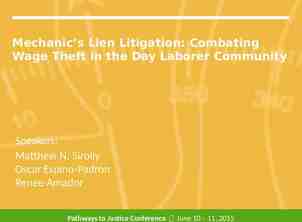HISTORY AND CULTURE OF THE PUNJAB BA-II SEMESTER
28 Slides84.52 KB

HISTORY AND CULTURE OF THE PUNJAB BA-II SEMESTER

1. The Mauryan Empire : Social, Economic and Religious Life At the time of Alexander’s invasion of the Punjab, a powerful empire ruled by a Nanda King was flourishing in the Gangetic plains. A young Indian prince Sandrocottas, with the help and guidance of a great statesman named Chanakya, overthrew the Nanda ruler and occupied the throne of Magadh. This Sandrocottas was Chandragupta Maurya. From Kautilya’s Arthashastra, Megasthenese’s Indica, the accounts left by the Greek historians and the edicts and pillar inscriptions of Ashoka, we get a picture of society in the Mauryan times. Besides, Buddhist religious books, works of contemporary art and architecture also throw valuable light on Social, economic and religious life under Mughals.

SOCIAL LIFE Changing Social Trends in Punjab. Caste System Slavery Position of Women Food Dress Amusements Ashram System Literature and Education

ECONOMIC LIFE Economic prosperity of Punjab Agriculture Cattle rearing Industry Trade Crafts and Artisans RELIGIOUS LIFE Brahmanism Shaivism Vaishnavism Jainism Buddhism Ajivikas Philosophy and religious toleration

2. Buddhism and Jainism: Impact on Punjab with Special reference to 4th Buddhist Council The sixth century B.C. witnessed a great religious ferment in the world. Buddhism and Jainism were the Hindu reform movements. They protested against the evils of the Hinduism and wanted to bring simplicity in the religion. Both religions believed in Non-violence , Karma and Nirvana or Moksha. Both show a kind of pessimism- a convicton that human life is full of misery. Buddhism and Jainism opposed the vedic sacrifices and rituals. Various factors contributed to the rise of Buddhism and Jainism. The vedic religion lost its original purity and had degenerated into cumbrous and meaningless rituals. The priestly class dominated the religion. Mahatma Buddha and Vardhman Mahavira voiced against all religious evils and put forward simple and practical teachings.

BUDDHISM Gautam Buddha, also known as Siddhartha, the founder of Buddhism, was born at Lumbini in 567 B.C. He was the only son of Suddhodhan. His mother’s name was Maya. He had a stepmother who brought him up, her name was Gautami. Childhood and marriage Four scenes The Great Renunciation Enlightenment TEACHINGS Four Noble Truths Eight-fold Noble Path or Ashtamarga. Middle path Nirvana Karma

Ethical code or morality Silent about the existence of God No faith in Yajnas, Sacrifices and rituals Opposed to Caste System No faith in sanctity of the Vedas and Sanskrit language No belief in doing Penance and Fasting JAINISM The followers of Jainism believe that there were twenty four Tirthankars. The first Tirthankar was Rishabha and there is nomention of next twenty one Tirthankars. The twenty one Tirthankar was Parsvanatha and twenty-fourth was Mahavira. Mahavira is considered to be the real founder of Jainism. He was born at Vaishali . The original name of Mahavira was Vardhaman. His Father’s name was Siddhartha. His mother Trishala was the sisiter of Lichchhavi prince Chetaka.

TEACHINGS Nirvana Tri-Ratna( three fold path) Ahimsa Hard Penance Five Mahavratas (five vows) Karma and trnsmigration of soul Stages of Knowledges Negation of God Nivriti marg Freedom to women Belief in soul power Condemned Caste System No belief in Yajans and Rituals No faith in the sanctity of the Vedas and Sanskrit language

CIRCUMSTANCES LEADING TO THE FOURTH BUDDHIST COUNCIL Three Buddhist Councils The division between the Southern and Northern Boddhis To ease the rules regarding monks New Buddhist Literature Mahasangghikas in Andhra Adoption of Buddhism by Kanishka Beginning of a new epoch Unity in Buddhism Sanskrit replaced Pali Mahayanism, the new sect SIGNIFICANCE

3. The Kushanas : Impact of Kanishka’s rule on Punjab The Kushanas were a Turkish nomadic tribe of shepherds called the Yue-chi or the Yakshas by the Chinese historians. The first Kushana King in the North-west was Kujula Kadphises or Kadphises-I. Kujula was succeeded by his son Wima Kadphises whi conquered the Punjab by defeating the Saka Satraps of Taxila Kanishka was the most famous and the greatest ruler of the Kushan dynasty. Accoding to R.S. Tripathi, Kanishka was a cpable general like Chandragupta Maurya. When he came to the throne, he was the master of Bactria, Afghanistan, Baluchistan, Punjab and Sindh.

IMPACT OF KANISHKA’S RULE ON PUNJAB Punjab ruled beyond its border Kanishka’s rule provided peace and order to Punjab Decentralisation of Powers Introduction of Cavalry in Army Spread of Buddhism Development of Art and Architecture Progress in the field of literature Development of trade Impact on Dress

4. Gandhara School of Art: Salient Features A distinctive style of Art The Gandhara Art had influence of Greek Art The theme and subject was Indian The Gandhara Art was a passing phase of Indian Art A lively commentary of the life of Buddha Realistic manner in shaping human body Idols with Art and Ornaments Gandhara art wth rich caring Elements of Greek Art The greeco-Roman architectural impact on Stupa structure

5. The Guptas : Cultural and Scientific Developments CULTURAL DEVELOPMENTS SOCIAL LIFE Joint Family System Caste System Ashram System Slavery Position of Women General Character of the people Dress and Ornaments Foods and Drinks Amusements Marriage

ARCHITECTURE Temple building Buddhist buildings Cave Architecture SCULPTURE The Buddha Boddhisatva Images Hindu Sculpture PAINTING Terracotta EDUCATION LITERATURE PHILOSOPHY RELIGION

SCIENTIFIC DEVELOPMENTS Mathematics Astronomy Astrology Medical Science Metallurgy and Coins

6.Position of Women : Under the Mauryas, the Guptas and the Vardhanas POSITION OF WOMEN UNDER MAURYAS Considerable freedom was permitted to women Right to education Institution of Marriage Remarriage and divorce Purdah System Secret and Security services for Women Right to property Sati System The institutuion of Prostitution

POSITION OF WOMEN UNDER GUPTAS Right to freedom Women education Share in Administration The beauty of Women was praised The institution of marriage Widow Marriage Lower age of girl marriage Right to property The custom of Sati Practice of Niyoga

POSITION OF WOMEN UNDER VARDHANAS The birth of a girl a source of sorrow Female Education Institution of Marriage Age of Marriage Inter-Caste Marriages Remarriage of Widows The System of Dowry The Purdah System The custom of Sati

7. Depiction of Punjab in the accounts of Chinese travellers Fahien and Hieun-Tsang FAHIEN’S ACCOUNT SOCIAL AND ECONOMIC CONDITION OF THE PEOPLE DURING THE REIGN OF Chandragupta II Splendour of Patliputra Certain localities unprosperous RELIGIOUS CONDITION HIEUN TSANG’S ACCOUNT Description of King’s personality Description of Harsha’s administration Land Settlement Judicial System Descriiption of Kanauj and Prayag

SOCIAL AND ECONOMIC CONDITION Society Dress and cleanliness Food Caste System Postion of Women High Moral Standards RELIGION AND EDUCATION Harsha’s religious tolerance Nalanda University

8. Main Developments in Literature THE VEDIC LITERATURE The Rigveda The Samaveda The Yajurveda The Atharveda The Brahmanas The Aranyakas The Upnishads The Vedangas The Sutras Ramayana and Mahabharata The Bhagvad Gita Puranas and Smritis

DEVELOPMENT OF LITERATURE DURING KUSHANA PERIOD Buddha Charita Saundarananda Kavya Sriputra- prakarma Shradhopada Vajrasuchi Gandistrotragatha Mahamadhyka Mahavibhasha Charak Samhita LITERATURE IN GUPTA PERIOD Yogachari Bhuma Shastra Mahayanasamparigraha Mahayanasutra Abhi-dharma Kosha Vijnapti-matrata

LITERATURE IN THE VARDHANA AGE Kadambri Harshacharitra Chandishataka Mukatadikita Mayurshataka Tattava-samdesha-shastra Priyadarshika Nagananda Suprabhatastitra Ashtamahesari-chichitya-stotra Linganushasna Brahmasiddhanta Khanda-khadyka

9. Education : Significant Developments : Taxila System of education- Every learned teacher assisted by his senior pupils was an institution by himself. The teacher admitted as many students as he liked. Subjects of study- The Vedas, grammar, philosophy, eighteen shilpas or crafts were the principal subjects selected for specialisation. Among the shilpas were included medicine, surgery, archery, astronomy, astrology, commerce, agriculture, magic,dance and painting. Decay of the University Fame of the Taxila University

10. Society on the eve of Turkish invasion on Punjab SOCIAL LIFE Rigid Society Rituals and Superstitions Caste system Position of Women The Matrimonial System Food and Drinks Dress and Ornaments Amusements Social Convention

ECONOMIC LIFE Agriculture Industries Trade and Commerce RELIGIOUS LIFE Religious beliefs and practices Buddhism Jainism Zoroastrianism Hinduism The tradition of the Siddhas.

11. Punjab in the Kitab-ul-Hind of Alberuni POLITICAL CONDITION Kushanas and Kanishkas Sakas and Vikramaditya Different Calenders The Ghaznavid Turks Hindushahis Annexation of Punjab with Ghaznavid Empire SOCIAL CONDITION Superiority Complex and no link with the outer world Broad mindedness Decline due to Neo-Bramanism Hindu behaviour towards Muslims Institution of Varna or Caste System

RELIGIOUS CONDITION Nature of God Worship of different Gods Idolatory Hindu Scriptures Sufism Decline of Buddhism Pilgrimage Fasting Astronomy and Astrology






